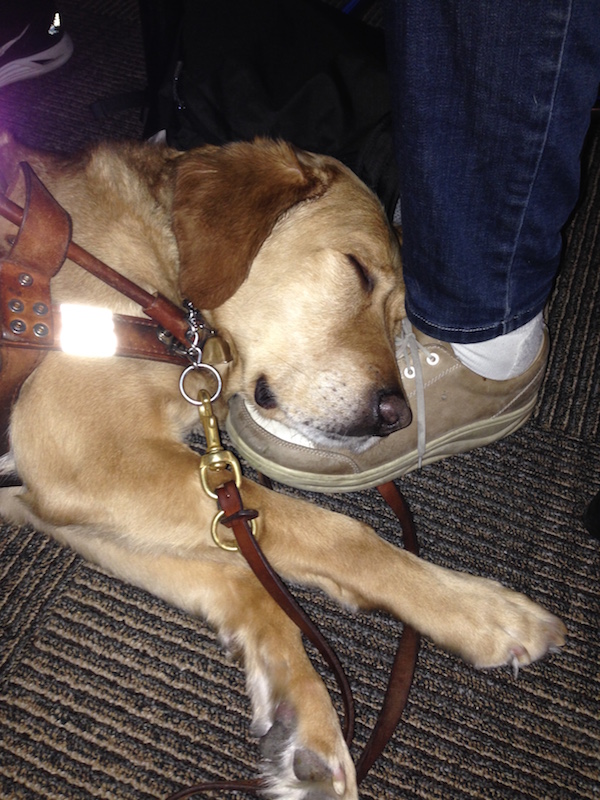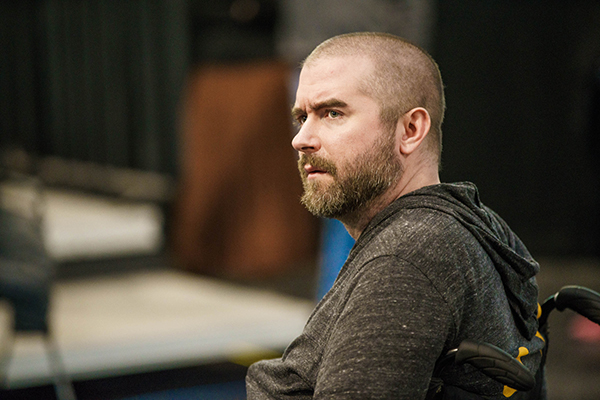How can people who are blind navigate airports on their own?
April 9, 2016 • 22 Comments • Posted in blindness, guide dogs, Seeing Eye dogs, technology for people who are blind, travel, UncategorizedHello from the Pacific Northwest – my Seeing Eye dog Whitney and I flew here from Chicago Wednesday for Sisters Weekend. The long flight from Seattle to Chicago gave me time to write out answers to questions I get about how I navigate O’Hare alone with my Seeing Eye dog:

Whitney makes the most of travel time.
- How do you get to the airport? Many people who are blind use public transportation to get to airports, but I’m afraid of using the subway alone with my Seeing Eye dog – I’m nervous about falling into the tracks. I’d be open to taking a Chicago Transit Authority bus, but I’d want to do a trial run ahead of time to know exactly where they’d be dropping me off. I usually use a hotel shuttle, taxi, limo, or van service, and I tip well.
- Where do you tell them to drop you off? Before I leave home, I check and double-check which airline I’m using and have the driver let me off at that specific Curbside check-in. Even if I’m not checking a bag, the workers at curbside check-in can check me in, get my boarding pass and sign me in for airport assistance. The curbside check-in worker guides my Seeing Eye dog and me to a seat inside and lets me know what my call number is. I tip them well.
- What do you do in the waiting area? I empty my pockets and put my change, iPhone, keys, and all into a compartment of my carry-on (will make it easier to go through security). Then I listen for a red cap to come call out my assigned number.
- How do you get to security? When a red cap calls our number, I get their attention and have them place my carry-on bag onto the seat of the wheelchair they brought along. I give my Seeing Eye dog the “follow” command and we shadow the red cap to the security line.
- How do you get into the screening area? For obvious reasons, I don’t have a valid driver’s license. I use a State of Illinois ID card instead, and show that along with my boarding pass as I enter the screening area. I have a cool wallet with a long pocket that holds my boarding pass and ID in it, very handy if/when I need them again at the gate.
- How do you get through security? I take my laptop computer and hand it to my airport assistant to place in a bin along with my shoes, jacket, and carry-on bag.
- How do you get through the magnetometer? After giving my Seeing Eye dog the “sit” command, I lengthen her leash and give her a “rest” command so she’ll sit still while I let the TSA screener know how I intend on getting through. My dog sits while I explain, and her leash remains in my left hand as I extend my right hand to the scrrener and ask them to pull me through the arch. If I brush against the interior wall by mistake, the alarm sounds. I remind my Seeing Eye dog to “rest” where she is and I return, turn around, extend my right hand to the screener and walk through the arch again. Once I get verbal confirmation from the TSA agent that I’ve cleared successfully, I turn around and call the dog to come through. The alarm goes off when my dog comes through, but going through by myself ahead of my dog makes it clear to the screeners that her harness and leash set off the alarm, not me.
- So do they have to wand the dog, then? Sometimes the screener wands her harness, and they always feel around her collar and pet her to inspect as well. I often quip to the TSA worker that my dog is the only creature who actually likes going though security. “It’s the only time I let someone pet her when her harness is on!”
- How do you get your stuff off the conveyor belt? It’s important for me to remember what color jacket I was wearing, what shoes I had on and what type of laptop I use so I can describe them to the red cap helping me — they collect my things once they’ve cleared security. I’ve added Braille stickers to some of the keys on my laptop. So I often open it quickly and feel the keys to confirm its mine.
- How do you find the gate from there? The red cap knows where the gate is, so I give my dog a “follow!” command and we shadow them from there. Once we’re at the gate, the red cap finds me a seat, heads to the desk with my boarding pass and returns with a pre-boarding ticket for us. I tip my red cap well.
Usually at this point I wait for someone from the airline to approach us and let us know they’re about to announce pre-boarding. I give my dog the “follow” command and follow the staff member to the jetway, hand over the ticket, board the plane, find our window seat and position my Seeing Eye dog under the seat in front of me with her head sticking out between my feet
On Wednesday, my sister Bev would be boarding along with my Seeing Eye dog and me once her flight from Grand Rapids arrived. After saying good bye to the red cap, I took my iPhone out and used VoiceOver to send Bev a text: “At gate.” Bev’s text came back immediately. “At airport Cubs bar. Meet you at gate soon.” Right then I knew: it was going to be an entertaining weekend with the sisters!




